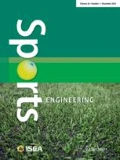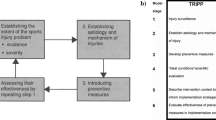Abstract
Angular acceleration of the head has long been recognized as a biomechanical mechanism for traumatic brain injury. In sporting events as well as during bicycle and motorcycle accidents, this angular acceleration may occur with or without direct contact against a rigid surface. The objective of this research was to investigate the effect of combined indirect and direct loading on headform kinematic response and resulting brain injury predictors produced by finite element modeling. This was accomplished by conducting a series of guided free-fall tests that were designed to subject the headform to specific loading conditions—indirect loading (IL), direct loading (DL), and combined indirect/direct loading (IDL). Three different helmet types were selected for testing (bicycle, hockey and football). For the helmet types tested, the IDL condition resulted in significantly higher values of angular acceleration (6600–11,100 rad/s2), maximum principal strain (17.8–31.2), Von Mises stress (9.5–9.8 kPa), and cumulative strain damage measure at 15 % strain (2.7–7.7 %) than IL or DL alone. This trend was consistent across all helmet types and demonstrates the deleterious effects of combined loading on the brain tissue. These results also provide some insight into how seemingly similar impacts can produce substantial differences in brain injury outcome.







Similar content being viewed by others
References
Broglio SP, Surma T, Ashton-Miller JA (2012) High school and collegiate football athlete concussions: a biomechanical review. Ann Biomed Eng 40(1):37–46
Nakaguchi H, Fujimaki T, Ueki K et al (1999) Snowboard head injury: prospective study in Chino, Nagano, for two seasons from 1995 to 1997. J Trauma 46(6):1066–1069
Langlois JA, Rutland-Brown W, Wald MM (2006) The epidemiology and impact of traumatic brain injury: a brief overview. J Head Trauma Rehabil 21(5):375–378
Lincoln AE, Caswell SV, Almquist JL, Dunn RE, Norris JB, Hinton RY (2011) Trends in concussion incidence in high school sports: a prospective 11-year study. Am J Sports Med 39(5):958–963
Omalu BI, DeKosky ST, Minster RL et al (2005) Chronic traumatic encephalopathy in a national football league player. Neurosurgery 57:128–134
Omalu BI, DeKosky ST, Hamilton RL et al (2006) Chronic traumatic encephalopathy in a national football league player: part II. Neurosurgery 59:1086–1092
Casson IR, Viano DC, Powell JW, Pellman EJ (2010) Twelve years of national football league concussion data. Sports Health 2(6):471–483
Gavett BE, Stern RA, McKee AC (2011) Chronic traumatic encephalopathy; a potential late effect of sport-related concussive and subconcussive head trauma. Clin Sports Med 30:179–188
Cantu RC (2000) Biomechanics of head injury. In: Neurologic athletic head and spine injuries. WB Saunders Company, USA
Gennarelli TA, Thibault LE (1985) Biomechanics of head injury. Neurosurgery 2:1531–1536
Meaney DF, Smith DH (2011) Biomechanics of concussion. Clin Sports Med 30(1):19–31
Hardy WN, Foster C, Mason M et al. (2001) Investigation of head injury mechanisms using neutral density technology and high-speed biplanar x-ray. In: Proceedings of the 45th Stapp Car Crash Journal, pp 337–368
King A, Yang, K, Zhang L (2003) Is head injury caused by linear or angular acceleration? In: Proceedings of the IRCOBI Conference, pp 1–12
Gurdjian ES, Lissner HR, Evans FG et al (1961) Intracranial pressure and acceleration accompanying head impacts in human cadavers. Surg Gynecol Obstetrics 113:185–190
Post A, Oeur A, Hoshizaki B et al (2012) The influence of centric and non-centric impacts to American football helmets on the correlation between commonly used metrics in brain injury research. In: Proceedings of the IRCOBI Conference, pp 419–429
Walsh ES, Rousseau P, Hoshizaki TB (2011) The influence of impact location and angle on the dynamic impact response of a Hybrid III headform. J Sport Eng 13(3):135–143
Viano DC, Pellman EJ, Withnall C et al (2006) Concussion in professional football: performance of newer helmets in reconstructed game impacts—part 13. Neurosurgery 59:591–606
Post A, Oeur A, Hoshizaki B et al (2013) An examination of American football helmets using brain deformation metrics associated with concussion. Mat Design 45:653–662
Post A, Oeur A, Hoshizaki B et al (2013) Examination of the relationship between peak linear and angular accelerations to brain deformation metrics in hockey helmet impacts. Comput Methods Biomech Biomed Eng 16(5):511–519
Zhang L, Dwarampudi R, Yang KH et al (2003) Effectiveness of the football helmet assessed by finite element modeling and impact testing. In: Proceedings of the IRCOBI Conference, pp 27–38
Hurt HH, Thom DR (1992) Motorcyclist head injury mechanisms—with and without helmets. In: Proceedings of the 36th Annual Meeting of the Association for the advancement of automotive medicine, pp 235–250
Smith TA, Tees D, Thom DR et al (1994) Evaluation and replication of impact damage to bicycle helmets. Acc Anal Prev 26(6):795–802
Pellman EJ, Viano DC, Tucker et al (2003) Concussion in professional football: reconstruction of game impacts and injuries. Neurosurgery 53:799–814
Viano DC, Withnall C, Halstead DP (2012) Impact performance of modern football helmets. Ann Biomed Eng 40(1):160–174
Rowson S, Duma SM (2011) Development of the STAR evaluation system for football helmets: integrating player head impact exposure and risk of concussion. Ann Biomed Eng 39(8):2130–2140
Virginia Tech Helmet Ratings—May (2013) http://www.sbes.vt.edu/helmet.php. Accessed 27 Mar 2014
Mueller F, Cantu R (1977) Annual survey of catastrophic football injuries 1977–2012. University of North Carolina, USA
Thompson RS, Rivara FP, Thompson DC (1989) A case-control study of the effectiveness of bicycle safety helmets. N Engl J Med 320(21):1361–1367
Yoganandan N, Li J, Zhang J et al (2008) Influence of angular acceleration-deceleration pulse shapes on regional brain strains. J Biomech 41:2253–2262
Fleisig GS, Barrentine SW, Escamilla RF et al (1996) Biomechanics of overhand throwing with implications for injuries. Sports Medicine 21:421–437
Richards D, Carhart M, Scher I et al (2008) Head kinematics during experimental snowboard falls: implications for snow helmet standards. J ASTM Int 5(6):JAI101406
Kleiven S (2007) Predictors for traumatic brain injuries evaluated through accident reconstruction. In: Proceedings of the 51st Stapp Car Crash Conference, pp 81–114
Ommaya AK, Yarnell AP, Hirsch A et al (1967) Scaling of experimental data on cerebral concussions in sub-human primates to concussion threshold in man. In: Proceedings of the 11th Stapp Car Crash Conference
Ommaya AK, Hirsch A (1971) Tolerances for cerebral concussion from head impact and whiplash in primates. J Biomech 4(1):13–21
Margulies SS, Thibault LE (1989) An analytical model of traumatic diffuse brain injury. J Biomech Eng 111:241–249
Margulies SS, Thibault LE, Gennarelli TA (1990) Physical model simulations of brain injury in the primate. J Biomech 23:823–836
Margulies S, Thibault LE (1992) A proposed tolerance criterion for diffuse axonal injury in man. J Biomech 25(8):917–923
Gennarelli TA, Thibault LE, Adams JH et al (1982) Diffuse axonal injury and traumatic coma in the primate. Annals of Neurology 12:564–574
Gurdjian ES, Roberts VL, Thomas LM (1966) Tolerance curves of acceleration and intracranial pressure and protective index in experimental head injury. J Trauma 6:600–604
NOCSAE (2013) Standard test method and equipment used in evaluating the performance characteristics of protective headgear/equipment. National Operating Committee on Standards for Athletic Equipment: NOCSAE DOC (ND)001-11m13
Mertz HJ (1985) Biofidelity of the hybrid III head. In: Backaitis SH, Mertz HJ (eds) Hybrid III: the first human-like crash test dummy. PT-44 Society of Automotive Engineers, Warrendale, pp 111–120
Culver C, Neathery R, Mertz HJ (1985) Mechanical necks with humanlike responses. In: Backaitis SH, Mertz HJ (eds) Hybrid III: the first human-like crash test dummy. PT-44 Society of Automotive Engineers, Warrendale, pp 147–161
Horgan TJ, Gilchrist MD (2003) The creation of three-dimensional finite element models for simulating head impact biomechanics. I J Crash 8(4):353–366
Horgan TJ, Gilchrist MD (2004) Influence of FE model variability in predicting brain motion and intracranial pressure changes in head impact simulations. I J Crash 9(4):401–418
Nahum AM, Smith R, Ward CC (1977) Intracranial pressure dynamics during head impact. In: Proceedings of the 21st Stapp Car Crash Conference, pp 339–366
Hardy WN, Foster CD, Mason MJ et al (2001) Investigation of head injury mechanisms using neutral density technology and high-speed biplanar x-ray. In: Proceedings of the 45th Stapp Car Crash Journal, vol 45. pp 337–68
Zhang L, Yang KL, King AI (2004) A proposed injury threshold for mild traumatic brain injury. J Biomech Eng 126(1):226–236
Bandak FA, Eppinger RH (1995) A three-dimensional finite element analysis of the human brain under combined rotational and translational acceleration. Stapp Car Crash J 38:145–163
Takhounts EG, Eppinger RH, Campbell JQ et al (2003) On the development of the SIMon Finite Element Head Model. Stapp Car Crash J 47:107–133
Acknowledgments
This work was supported in part by the National Operating Committee on Standards for Athletic Equipment (NOCSAE) and by Dynamic Research, Inc. The authors would like to acknowledge the contribution of Mr. Rob Roy for initial concept testing.
Author information
Authors and Affiliations
Corresponding author
Rights and permissions
About this article
Cite this article
Smith, T.A., Halstead, P.D., McCalley, E. et al. Angular head motion with and without head contact: implications for brain injury. Sports Eng 18, 165–175 (2015). https://doi.org/10.1007/s12283-015-0175-5
Published:
Issue Date:
DOI: https://doi.org/10.1007/s12283-015-0175-5




